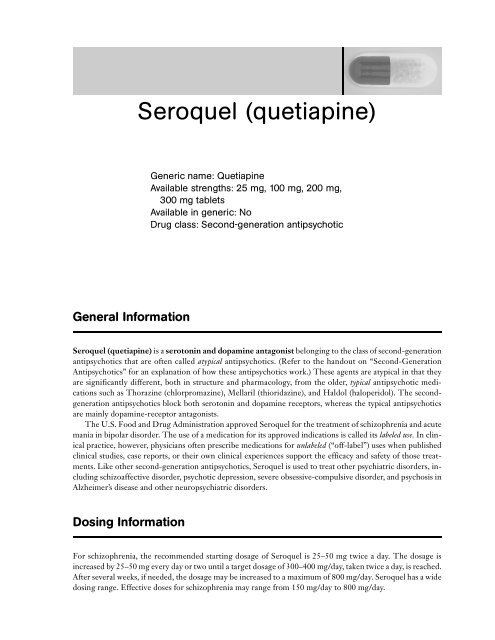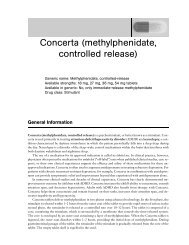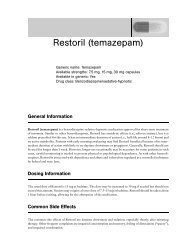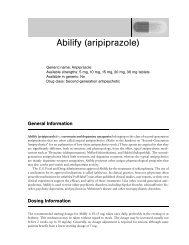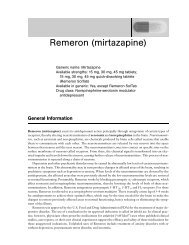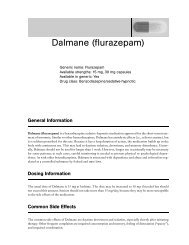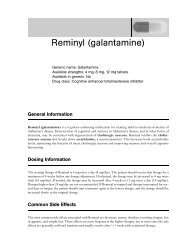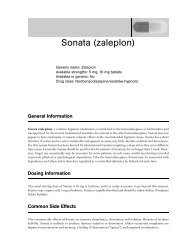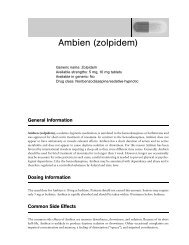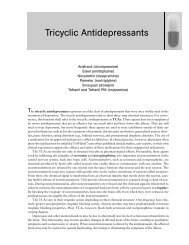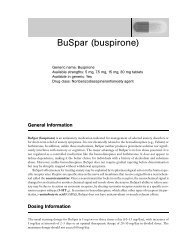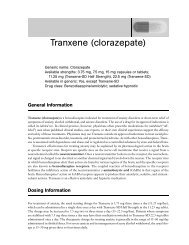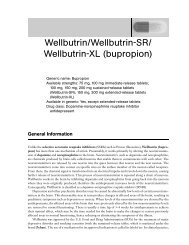Seroquel (quetiapine)
Seroquel (quetiapine)
Seroquel (quetiapine)
You also want an ePaper? Increase the reach of your titles
YUMPU automatically turns print PDFs into web optimized ePapers that Google loves.
<strong>Seroquel</strong> (<strong>quetiapine</strong>)<br />
Generic name: Quetiapine<br />
Available strengths: 25 mg, 100 mg, 200 mg,<br />
300 mg tablets<br />
Available in generic: No<br />
Drug class: Second-generation antipsychotic<br />
General Information<br />
<strong>Seroquel</strong> (<strong>quetiapine</strong>) is a serotonin and dopamine antagonist belonging to the class of second-generation<br />
antipsychotics that are often called atypical antipsychotics. (Refer to the handout on “Second-Generation<br />
Antipsychotics” for an explanation of how these antipsychotics work.) These agents are atypical in that they<br />
are significantly different, both in structure and pharmacology, from the older, typical antipsychotic medications<br />
such as Thorazine (chlorpromazine), Mellaril (thioridazine), and Haldol (haloperidol). The secondgeneration<br />
antipsychotics block both serotonin and dopamine receptors, whereas the typical antipsychotics<br />
are mainly dopamine-receptor antagonists.<br />
The U.S. Food and Drug Administration approved <strong>Seroquel</strong> for the treatment of schizophrenia and acute<br />
mania in bipolar disorder. The use of a medication for its approved indications is called its labeled use. In clinical<br />
practice, however, physicians often prescribe medications for unlabeled (“off-label”) uses when published<br />
clinical studies, case reports, or their own clinical experiences support the efficacy and safety of those treatments.<br />
Like other second-generation antipsychotics, <strong>Seroquel</strong> is used to treat other psychiatric disorders, including<br />
schizoaffective disorder, psychotic depression, severe obsessive-compulsive disorder, and psychosis in<br />
Alzheimer’s disease and other neuropsychiatric disorders.<br />
Dosing Information<br />
For schizophrenia, the recommended starting dosage of <strong>Seroquel</strong> is 25–50 mg twice a day. The dosage is<br />
increased by 25–50 mg every day or two until a target dosage of 300–400 mg/day, taken twice a day, is reached.<br />
After several weeks, if needed, the dosage may be increased to a maximum of 800 mg/day. <strong>Seroquel</strong> has a wide<br />
dosing range. Effective doses for schizophrenia may range from 150 mg/day to 800 mg/day.
Page 2 of 4<br />
SECOND-GENERATION ANTIPSYCHOTICS<br />
In treatment of acute mania in bipolar disorder, the usual starting dosage is 100 mg/day, divided in twicedaily<br />
dosing, and rapidly increased to 400 mg/day by the fourth day. If needed, the dosage is increased by<br />
200 mg/day to a maximum of 800 mg/day by day 7. As acute mania abates, <strong>Seroquel</strong> may be continued as a<br />
single agent or in combination with another mood stabilizer, such as Depakote. Dosage adjustments may be<br />
needed to find the lowest dosage required to maintain remission.<br />
A more cautious dosing approach is recommended for seniors or for patients with a medical condition,<br />
such as liver disease. The dosage should be increased slowly, with a lower starting and ending dosage.<br />
Common Side Effects<br />
The common side effects of <strong>Seroquel</strong> are drowsiness and dizziness. Drowsiness may be problematic during<br />
the daytime. Taking a larger portion of the divided dosage at bedtime and a smaller one in the morning may<br />
minimize daytime sleepiness. For example, if the total dosage were 300 mg/day, the patient would take 200 mg<br />
at bedtime and 100 mg in the morning.<br />
There is a very low incidence of extrapyramidal symptoms (EPS) from <strong>Seroquel</strong>. EPS are neurological<br />
disturbances produced by antipsychotics (or other causes) in the area of the brain that controls motor coordination.<br />
These side effects include muscle rigidity, tremors, drooling, restlessness, a “mask-like” facial expression,<br />
shuffling gait, and muscle spasms that result in abnormal posture (dystonia). EPS mimic Parkinson’s<br />
disease, and many of the signs and symptoms are common in both conditions. Some patients experience<br />
akathisia, which is a subjective sense of restlessness accompanied by fidgeting and inability to sit or stand still.<br />
EPS may be managed by decreasing the antipsychotic dosage or adding another medication (anticholinergic<br />
medication) to counteract the side effect.<br />
Patients frequently will gain weight when treated with <strong>Seroquel</strong>. It appears that <strong>Seroquel</strong> increases appetite<br />
and may produce some underlying metabolic changes. The major concern of this weight gain is the health<br />
consequences to the patient, including the potential for developing diabetes and increasing cholesterol and<br />
other lipids, which can increase the risk for cardiovascular disease. Furthermore, patients may want to stop<br />
taking their medication if they become self-conscious about putting on excessive weight. If this side effect becomes<br />
problematic, patients should not stop their medication, but should consult with their physician. Control<br />
of weight can usually be managed by diet and exercise without stopping <strong>Seroquel</strong>.<br />
<strong>Seroquel</strong> may block a compensatory response—the narrowing of blood vessels—that counterbalances postural<br />
change, resulting in a momentary drop in blood pressure when the person rises too rapidly, which may<br />
cause dizziness and lightheadedness. This reaction is known as orthostatic hypotension. Patients, especially<br />
seniors and those taking antihypertensive medications, need to be cautious and rise slowly to allow their body<br />
to adjust to the change in position, avoiding a sudden drop in their blood pressure.<br />
Adverse Reactions and Precautions<br />
<strong>Seroquel</strong> may cause drowsiness and sedation and impair physical coordination and mental alertness. Patients<br />
should avoid potentially dangerous activities, such as driving a car or operating machinery, until they are sure<br />
that these side effects will not affect their ability to perform these tasks.<br />
Tardive dyskinesia (TD) is a potential adverse reaction from antipsychotic medications. It consists of abnormal<br />
involuntary movements. It is a potentially irreversible condition that includes “pill-rolling” movements<br />
of the fingers, darting and writhing movements of the tongue, lip puckering, facial grimacing, and shoulder<br />
or neck movements. The risk of TD is believed to increase as the duration of treatment and the total cumulative<br />
amount of antipsychotic medications prescribed to the patient increases. The risk of TD associated with<br />
second-generation antipsychotics is significantly lower than with conventional antipsychotics.
<strong>Seroquel</strong> (<strong>quetiapine</strong>)<br />
Page 3 of 4<br />
Neuroleptic malignant syndrome (NMS) is a rare, toxic reaction to antipsychotics. The symptoms are<br />
severe muscle stiffness, rigidity, elevated body temperature, increased heart rate and blood pressure, irregular<br />
pulse, and sweating. NMS may lead to delirium and coma. It can be fatal if medical intervention is not immediately<br />
provided. There is no test to predict whether an individual may be susceptible to developing NMS<br />
when exposed to an antipsychotic. Thus NMS must be recognized early because it is a medical emergency<br />
that requires immediate discontinuation of the antipsychotic, hospitalization, and intensive medical treatment.<br />
There have been reports of patients who showed transient and asymptomatic increases in liver enzymes,<br />
but it was concluded that the elevated enzymes were temporary and not serious. Nevertheless, patients’ liver<br />
function should be monitored by laboratory tests before beginning treatment with <strong>Seroquel</strong> and then periodically<br />
during treatment.<br />
Use in Pregnancy and Breastfeeding: Pregnancy Category C<br />
<strong>Seroquel</strong> has not been tested in women to determine its safety in pregnancy. The effects of the medication on<br />
the developing fetus in pregnant women are unknown. In animal studies, there was no evidence of harm to<br />
the fetus when exposed to <strong>Seroquel</strong>. Animal studies, however, are not always predictive of effects in humans.<br />
Women who are pregnant or may become pregnant should discuss this with their physician. Some women<br />
may experience a recurrence of their psychosis when they stop <strong>Seroquel</strong>. In these circumstances, the physician<br />
may discuss the need to restart the medication or seek an alternative medication or treatment.<br />
Nursing mothers should not take <strong>Seroquel</strong>, because small amounts will pass into breast milk and be ingested<br />
by the baby. If stopping the antipsychotic is not an alternative, breastfeeding should not be started or<br />
should be discontinued.<br />
Possible Drug Interactions<br />
Some medications when taken with <strong>Seroquel</strong> may result in drug interactions that alter their levels, which may<br />
produce undesired reactions. The possible drug interactions with <strong>Seroquel</strong> are summarized in the table below.<br />
Antihypertensive medications<br />
Nizoral (ketoconazole), Diflucan (fluconazole),<br />
and Sporanox (itraconazole)<br />
Tegretol (carbamazepine) and Dilantin (phenytoin)<br />
Central nervous system depressants<br />
Antihypertensives such as Catapres and Inderal<br />
may increase the risk for orthostatic hypotension.<br />
Antifungal agents may decrease the metabolism of<br />
<strong>Seroquel</strong>, thus increasing blood levels and the<br />
likelihood of unwanted side effects.<br />
Tegretol and Dilantin may decrease the blood levels<br />
of <strong>Seroquel</strong>, making it less effective in treating the<br />
symptoms of the illness.<br />
Sedating medications, such as barbiturates, benzodiazepines<br />
(e.g., Valium), narcotic analgesics, and<br />
antihistamines, may increase sedation when combined<br />
with <strong>Seroquel</strong>.<br />
Patients taking <strong>Seroquel</strong> should not consume alcohol because the combination may impair thinking, judgment,<br />
and coordination.
Page 4 of 4<br />
SECOND-GENERATION ANTIPSYCHOTICS<br />
Overdose<br />
The most common signs of <strong>Seroquel</strong> overdose include extreme sedation, orthostatic hypotension, confusion,<br />
rapid and irregular heart rate, muscle rigidity, and seizures. The outcome depends on the amount ingested<br />
and whether <strong>Seroquel</strong> was combined with other medications.<br />
Any suspected overdose should be treated as an emergency. The person should be taken to the emergency<br />
department for observation and treatment. The prescription bottle of medication (and any other medication<br />
suspected in the overdose) should be brought as well, because the information on the prescription label can<br />
be helpful to the treating physician in determining the number of pills ingested.<br />
Special Considerations<br />
• Do not discontinue <strong>Seroquel</strong> without consulting your physician.<br />
• If you miss a dose, take it as soon as possible that day. If it is close to your next schedule dose, skip the missed<br />
dose and continue on your regular dosing schedule, but do not take double doses.<br />
• <strong>Seroquel</strong> may be taken with or without food.<br />
• <strong>Seroquel</strong> may cause sedation and drowsiness, especially during initiation of therapy, and impair your alertness.<br />
Use caution when driving or performing tasks that require alertness.<br />
• Store the medication in its originally labeled, light-resistant container, away from heat and moisture. Heat<br />
and moisture may precipitate breakdown of the medication.<br />
• Keep your medication out of reach of children.<br />
If you have any questions about your medication, consult your physician or pharmacist.<br />
Notes


